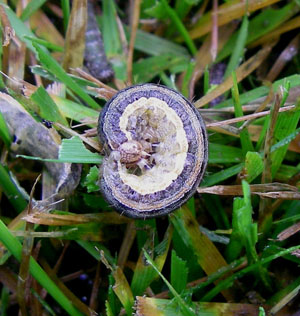|
We have been monitoring reports of very large infestations of armyworm moths flying into Kentucky this spring. Armyworms move north with storms from the southern states each year and depending upon how and where the storms blow will dictate when and how many moths we have to deal with. Fortunately, in Indiana we have not seen the huge numbers of moths that Kentucky reported earlier this spring, however, we do have our fair share. The moths that have come our way have already laid eggs (normally in grassy vegetation such as in ditch banks, vacant lots, or in agricultural areas such as wheat, grass hay, and grass cover crops). This is important for turfgrass managers because when these grasses mature and dry down, armyworms leave them and often find their way to the green, succulent turfgrasses that we manage. Wheat is maturing very quickly right now and we are already hearing reports of armyworms moving into adjacent golf courses or residential neighborhoods. Mature fall armyworms measure 1½ inches long with a body color that ranges from green to brown or black with distinct longitudinal stripes on their body. They can be distinguished from similar caterpillars by the presence of a prominent inverted white “y” on their head. Armyworm feeding usually is from the margins of the leaf toward the midrib. This gives turfgrass a ragged appearance. When infestations are high, most of the plant may be consumed. Preventive insecticide treatments are not warranted because outbreaks are so sporadic and mortality due to natural causes is usually high. The key to controlling fall armyworm is early detection because infestations of fully mature larvae feed voraciously and can very quickly damage turfgrass. Thresholds are not well developed for fall armyworm in turfgrass, but we suggest treatment when average counts reach two or three ½-inch larvae per square foot. Several biorational controls such as Bacillus thuringiensis var. kurstaki, Steinernema glaseri or Heterorhabditis bacteriophora nematodes, or spinosad can be effective on armyworms, however, because of the large size of the migrating worms and the amount of damage they can do in a short time frame, most turfgrass managers prefer a more fast acting solution such as with conventional insecticides containing acephate, bifenthrin, carbaryl, cyfluthrin, lambda-cyhalothrin, trichlorfon, permethrin or others. |
 |
 |
|
 |
|
Armyworm Infested Turf (Photo by Doug Akers) |